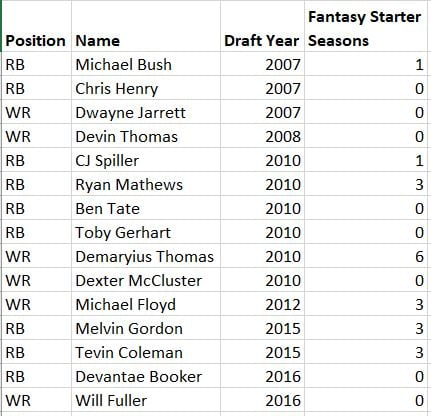This time of year we are inundated with what seem like 1000’s of buy-low articles or tweets. What does “buy-low” even mean? It got me wondering how often these players that flop actually bounce back when closely reviewing the advanced stats, metrics, and analytics profiles. This lead me down a bit of a rabbit hole and I have a whole bunch of ADP data that tells some interesting tales.
To qualify as a buy-low a player must have had a first round rookie pick ADP in May of their draft year, then they must have fallen by 12 spots or more by the May after their rookie year. I then looked at what happened after their 2nd year in the NFL. A player was considered a “Boom” if they increased by 12 spots or more from year over year. The sample includes players from 2007 to 2016 (We haven’t hit May 2019 as of this writing so the 2017 class isn’t finalized yet).
Buying low on rookies after a disappointing rookie year has not been a very effective strategy. A 32.61% chance of the player recouping value is not a winning bet.
Lets take a closer look at the players that were able to turn their careers around after being freshman flops.
The Boomers
Because of the limited sample at QB and TE I will only be diving into the WR’s and RB’s.
I looked at the players that boomed in their 2nd year and whether or not they were good long term investments. To determine this I used 3 or more fantasy starter seasons as a baseline for being a good long term investment. To be a fantasy starter, a player needed to finish inside the top 24 RB’s or the top 36 WR’s depending on their position.
So of these 15 players that returned value on their buy-low price only 5 were good long term investments (5/15 = 33%). Or 5 of 46 players that busted in year 1 turned into fantasy producers (10.9%). That is a terrifying hit rate.
https://www.youtube.com/watch?v=E6I4n2lsd6o
Next I looked at the success cases to see if they had anything in common, below is a high level look at their similarities.
Draft Capital Indicator
Does draft capital matter? All of our quality long term investments were drafted in the first round except for Tevin Coleman.
Ryan Mathews – 1.12
Demaryius Thomas – 1.22
Michael Floyd – 1.13
Melvin Gordon – 1.15
Tevin Coleman – 3.09
Among the misses there are only two first round picks, C.J. Spiller and Will Fuller. The rest were drafted in the 2nd round or beyond. Meaning, if you own one of these busts and they are not a first round pick, trade them right now. It should be noted that both Spiller and Fuller are not featured player size at their respective positions. C.J. Spiller has a 4th-percentile BMI at 5’11 and 196 pounds. Will Fuller is a very slender 6’0 and 186 pounds. 4 of 5 of our quality long-term investments have featured size with the exception being Tevin Coleman.
College Production Metrics
Does college production matter? All of the long term hits were highly productive in college based on College Dominator.
Ryan Mathews – 35.9% – 82nd percentile
Demaryius Thomas – 70.9% – 99th
Michael Floyd – 39.4% – 79th
Melvin Gordon – 47.1% – 96th
Tevin Coleman – 43.2% – 94th
There were several misses that had solid college production profiles but most of them did not have 1st round NFL draft capital. Both Spiller and Fuller were productive in college.
C.J. Spiller – 33.9% – 77th percentile
Will Fuller – 46.7% – 92nd
Buy-low Trends
The lesson to be learned here is among the buy-low candidates each year look for draft capital, high college production, and feature size. If you have a bust on your hands or you are debating trading for one, look at those three things first. If they check all 3 boxes its probably worth it. Otherwise it is fairly unlikely that you find yourself with a bounce back and it is even more unlikely that you will have a building block on your hands. What does this mean for 2018’s buy low players?
Top RB buy-low candidates
From the 2018 class, three running backs selected in the first three rounds busted:
Rashaad Penny, Seattle Seahawks
Draft capital – 1.27
College Dominator – 50.1% – 98th percentile
Featured size – 30.7 BMI – 58th percentile at 5’11 and 220 pounds
Check out Rashaad Penny on PlayerProfiler’s Updated Dynasty Rankings:
Royce Freeman, Denver Broncos
Draft capital – 3.07
College Dominator – 30.4% – 68th percentile
Featured size – 31.1 BMI – 69th percentile at 6’0 and 229 pounds
Ronald Jones, Tampa Bay Buccaneers
Draft capital – 2.06
College Dominator – 33.4% – 76th percentile
Featured size – 28.6 BMI – 17th percentile at 5’11 and 205 pounds
Buy Rashaad Penny and sell Royce Freeman and Ronald Jones, and pursue Penny most aggressively, because he is the only of the three to check all three boxes.





